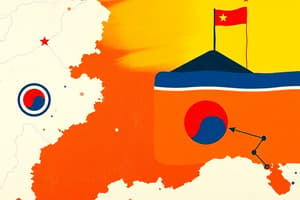Podcast
Questions and Answers
What role do business groups play in the Asian economic structure?
What role do business groups play in the Asian economic structure?
- They have no impact on business relations.
- They replace traditional market systems.
- They function as a combination of market and hierarchical forms. (correct)
- They operate only within government regulations.
What is a characteristic of the practice of Amakudari in Japan?
What is a characteristic of the practice of Amakudari in Japan?
- It facilitates formal connections between retired officials and business associations. (correct)
- It eliminates the need for lobbying by business groups.
- It encourages government officials to retire without prospects.
- It is discouraged by governmental policies.
Why are institutions considered path-dependent?
Why are institutions considered path-dependent?
- Because they are based on decentralized decision-making.
- Because they are universally applicable across all countries.
- Because changing them incurs significant costs. (correct)
- Because they can only be changed through radical reforms.
How does wage bargaining typically operate at the enterprise/sectoral level?
How does wage bargaining typically operate at the enterprise/sectoral level?
What was a significant economic response to the crisis in December 1997 in South Korea?
What was a significant economic response to the crisis in December 1997 in South Korea?
What impact do institutions have on firms and individual behavior?
What impact do institutions have on firms and individual behavior?
Which of the following is true regarding informal practices in Asian economies?
Which of the following is true regarding informal practices in Asian economies?
What happens if economic conditions favor incremental institutional change?
What happens if economic conditions favor incremental institutional change?
What was a primary policy during the export-led growth period from 1962 to 1972?
What was a primary policy during the export-led growth period from 1962 to 1972?
Which factors contributed to the emergence of chaebols in South Korea?
Which factors contributed to the emergence of chaebols in South Korea?
What characterized the Heavy and Chemical Industry Development policies during the 1970s?
What characterized the Heavy and Chemical Industry Development policies during the 1970s?
What was a significant economic policy shift during the stabilization, liberalization, and renewed growth phase from 1980 to 1996?
What was a significant economic policy shift during the stabilization, liberalization, and renewed growth phase from 1980 to 1996?
How is the narrow definition of a developmental state characterized?
How is the narrow definition of a developmental state characterized?
What was one of the anti-inflationary policy measures introduced during the period from 1980 to 1996?
What was one of the anti-inflationary policy measures introduced during the period from 1980 to 1996?
What type of policy is characterized by the state's strategic intervention in the market to facilitate industrial transformation?
What type of policy is characterized by the state's strategic intervention in the market to facilitate industrial transformation?
What was the significance of the National Investment Fund during the Heavy and Chemical Industry Development?
What was the significance of the National Investment Fund during the Heavy and Chemical Industry Development?
What was one effect of the limited import liberalization policy enacted during the 1962-1972 growth phase?
What was one effect of the limited import liberalization policy enacted during the 1962-1972 growth phase?
What describes the role of elite bureaucracy in the developmental state model?
What describes the role of elite bureaucracy in the developmental state model?
What was a significant feature of the Korean economy in the early 1960s?
What was a significant feature of the Korean economy in the early 1960s?
What was the primary focus of Korea's economic development strategy during the 5-year plan?
What was the primary focus of Korea's economic development strategy during the 5-year plan?
Which sector saw a significant increase in employment structure by 2002?
Which sector saw a significant increase in employment structure by 2002?
What characterized the changes in Korea's GDP structure over the decades?
What characterized the changes in Korea's GDP structure over the decades?
What approach did Korea take to attract investment during its economic development phase?
What approach did Korea take to attract investment during its economic development phase?
How did the industrial structure of Korea change from 1960 to 2002?
How did the industrial structure of Korea change from 1960 to 2002?
What was one of the key differences in industrialization strategies between East Asian countries and other late industrializers?
What was one of the key differences in industrialization strategies between East Asian countries and other late industrializers?
Which term best describes the 1960-1980 economic strategy in Korea?
Which term best describes the 1960-1980 economic strategy in Korea?
What was Korea's economic condition in the 1950s regarding exports?
What was Korea's economic condition in the 1950s regarding exports?
What role did domestic coalitions play in Korea's economic strategy?
What role did domestic coalitions play in Korea's economic strategy?
Flashcards are hidden until you start studying
Study Notes
Korean Economic Development
- The Korean economic model is a case study in late industrialization, transitioning from a primarily agricultural economy to a high-tech, export-driven powerhouse.
- Korea's development trajectory involved distinct phases: primary products export, import-substitution industrialization, and export-led growth, each guided by specific policies and institutional frameworks.
- Korea's success in industrialization differed from other late industrializers due to its strategic choice of export-led growth, which involved extensive government intervention and collaboration with private enterprise.
The International System
- Korea's economic development was greatly influenced by the international system throughout history.
- The Cold War era saw the United States heavily involved in Korean affairs, providing economic aid and military support.
- The international economic order, encompassing the World Bank, IMF, and other global institutions, played a significant role in shaping the Korean economic strategy.
Domestic Coalitions
- The Korean developmental state benefited from powerful domestic coalitions, particularly in the business sector and, to a lesser extent, labor.
- Chaebols, family-controlled conglomerates, emerged as key drivers of the Korean economy, supported by close government-business relationships.
Institutions and Ideas
- The Korean model was built upon a set of key institutions and ideas that shaped its economic trajectory.
- The developmental state, with its core concept of strategic government intervention in the market, provided a framework for industrial policy and economic growth.
- The focus on export-led growth and a "catch-up" strategy required substantial government support and collaboration with private enterprise, leading to the emergence of chaebols.
Transformation of the Korean Economy
- The 1960s marked a turning point for the Korean economy with government-led economic planning.
- The introduction of the Five-Year Plans, centered on export-led growth and industrialization, was a crucial step towards economic transformation.
- Between 1962 and 1972, the focus shifted towards export-led growth, and specific policies, such as currency devaluation, interest rate reform, and export incentives, were implemented to encourage production for global markets.
The Rise of Chaebols
- The Korean economic model evolved alongside the rise of the chaebols, often described as "state entrepreneurial capitalism."
- State intervention and active government support played a crucial role in fostering the growth of these powerful businesses.
- The chaebols' large size, diversified interests, and close ties to the government contributed to Korea's economic transformation.
Heavy and Chemical Industry Development (1970s)
- The 1970s saw a strategic shift towards heavy and chemical industries.
- Policies designed to promote specific industries, such as steel, machinery, and petrochemicals, involved subsidized loans, tax breaks, and investment incentives.
- This era also saw the government actively managing the financial system, including credit rationing and government guarantees for foreign loans.
Stabilization, Liberalization, and Renewed Growth (1980-1996)
- During the 1980s and 1990s, Korea moved towards stabilization and liberalization, focusing on policies to control inflation, deregulation, and market opening.
- The Heavy and Chemical Industry drive was scaled back, and emphasis was placed on supporting small and medium-sized enterprises (SMEs).
- This period saw the shift towards a more market-oriented approach while maintaining a significant role for the government in guiding the economy.
The Developmental State
- The "developmental state" is a key concept in understanding Korea's economic success.
- This approach involves a strong and strategic government role in promoting industrial transformation and economic growth.
- Specific policy areas, including industrial policy, financial policy, social policy, labor policy, and state-business relations, are crucial elements of the developmental state model.
- The developmental state relies on a well-trained and autonomous bureaucracy, like the Economic Planning Board (EPB) in Korea, to implement its policies and strategies effectively.
Explaining the Miracle: The Developmental State
- The Korean "miracle" of economic growth is explained by the efficient operation of the developmental state.
- This involved a strong and competent bureaucracy, like the EPB, with the capacity to implement well-defined industrial policies and financial strategies.
- The developmental state played a key role in facilitating economic growth by providing guidance, support, and necessary resources to the private sector.
Comparative Institutional Framework
- Institutions play a critical role in shaping economic development.
- Institutional arrangements, including rules, norms, and practices, vary from country to country and influence economic behavior.
- Institutions are generally path-dependent, making it difficult to change them after initial implementation due to the costs associated with change.
Institutional Change
- Institutional change tends to be incremental, evolving through a gradual process of adapting to new circumstances and challenges.
- Institutional change can be observed at different levels, such as sector-specific industrial regulations, national labor relations, or even informal practices within business communities.
The Importance of Institutions
- Institutions shape the behavior of individuals, firms, and governments, directly influencing economic outcomes.
- The development of institutions, their effectiveness, and their responsiveness to changing economic realities have significant implications for economic growth and sustainability.
Studying That Suits You
Use AI to generate personalized quizzes and flashcards to suit your learning preferences.




